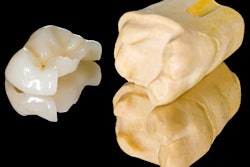
DrBicuspid.com is pleased to present the next installment of Leaders in Dentistry, a series of interviews with researchers, practitioners, and opinion leaders who are influencing the practice of dentistry.
Sammy Noumbissi, DDS, is the founder and president of the International Academy of Ceramic Implantology. He spoke with DrBicuspid.com in advance of the conference on ceramic implants in February 2018 in San Diego.
As conventional implants can have higher-than-expected failure rates and difficulties with osseointegration, Dr. Noumbissi is at the forefront of a movement to increase the use of ceramic implants.
DrBicuspid.com: What is a ceramic implant?
 Sammy Noumbissi, DDS, is the founder and president of the International Academy of Ceramic Implantology.
Sammy Noumbissi, DDS, is the founder and president of the International Academy of Ceramic Implantology.Dr. Noumbissi: A ceramic implant is a device intended for permanent implantation in the jawbone. It is made with composites of medical-grade ceramic powders, also known as bioceramics. Zirconia implants are not metal; they are made with other ceramic materials such as yttria and alumina. All these materials are initially harvested in nature as metal ores, but because of their properties as transitional metals they can, under highly sophisticated and complex industrial protocols, be converted into bioceramics.
The original ceramic implants were all made from single ceramic powders. They had poor flexibility and structural integrity. Today, these implants are made of ceramic composites that have contributed to making bioceramics more flexible and less brittle than the original ones. Ceramic implants integrate and have success rates comparable to coated titanium implants. As a matter of fact, there is more of a "true" integration of zirconia to bone versus titanium.
What are the most frequent questions general dentists ask you about these implants?
There is always an air of disbelief and doubt when I talk about these implants. I usually get asked these three questions:
- How can they be ceramic when they are made of zirconium?
- Aren't they prone to fracture?
- Is it possible for ceramics to integrate with bone?
I've found that there is a general lack of understanding of zirconia and its manufacturing process. Most dentists erroneously use the term zirconium when they refer to ceramic implants but effortlessly revert back to zirconia when they talk about prosthetics.
In patients, the soft tissue response to zirconia and zirconia implants has clinically and scientifically proved to be vastly superior than tissue around titanium implants and abutments (Implant Dentistry, February 2015, Vol. 24:1, pp. 37-41). Studies have shown more keratinized tissue, no discoloration, better vascularization, and overall soft tissue stability around ceramic implants (Journal of Periodontology, January 2006, Vol. 77:1, pp. 73-80). Finally, as a result of their low surface energy, zirconia ceramic implants have very limited plaque formation on their surface, leading to the consistent clinical observation of healthy and stable soft tissue.
What are some of the differences between ceramic and conventional implants?
Ceramic implants on the market are macroscopically similar to conventional ones but differ in many respects. In the U.S., we have five U.S. Food and Drug Administration-approved ceramic implant systems:
“Ceramic implants on the market are macroscopically similar to conventional ones but differ in many respects.”
- CeraRoot (CeraRoot)
- Straumann Pure (Straumann)
- Zeramex P6 and Zeramex T (Zeramex)
- Z5c, Z5m, Z5s, and more (Z-Systems)
- ZiBone (Coho Biomedical Technology)
Three of the five are available only in the monoblock, also known as a "one-piece" configuration. On the other hand, more recently there have been two-piece ceramic implants available with cementable and screw-retained prosthetic abutments, thus expanding the range of applications of ceramic implants.
The surfaces of ceramic implants are not coated, unlike conventional ones. To improve their osseointegration potential, their surface is modified by subtractive, rather than additive, methods, such as sandblasting or acid or laser etching. This is a unique development because the osseointegration is not taking place with a coating such as hydroxyapatite but directly with and into the implant material itself.
The thread design of ceramic implants is not as aggressive as that of metal implants. This is because there is a chance of thread chipping if they are too thin and sharp. Therefore, for most ceramic implant systems, insertion protocols mandate that the bone be tapped prior to implant insertion. Insertion torque values depending on the system and connection design range from 25 Newton cm (Ncm) to 35 Ncm.
Are there advantages to using ceramic implants?
Zirconia implants are different in terms of their component materials, surface treatment, thread design, and the manner in which hard and soft tissue responds to their surface. Zirconia is a much more stable material in the presence of body fluids and the harsh oral environment.
Given that it is a ceramic, it does not have a galvanic potential and, as a result, is immune to corrosion attack with no release of metal ions in the surrounding soft and hard tissue. Metallic ions release from metal implants and prosthetic components often lead to tissue discoloration and even peri-implant bone loss as a result of inflammation. A 2010 study showed that soft tissue around zirconia abutments have far less inflammation and inflammatory infiltrate compared with titanium (Materials, February 2010, Vol. 3:2, pp. 863-896).
Are there specific disadvantages to using these implants?
The learning curve on these implants can be a little steep, especially on the one-piece design. They require proper case selection and detailed planning, and, for most cases, fully guided surgery is highly recommended. Zirconia is not as flexible as metal; therefore, the prosthetic design and accurate surgical planning are paramount to reduce off-axis forces that are better tolerated by metals.
The cost of ceramic implants today is still around 30% higher than conventional implants, but with emerging manufacturing technologies such as injection molding and others, I see a reduction in costs in the next couple of years.



















